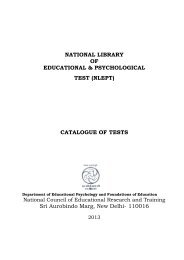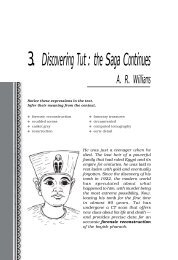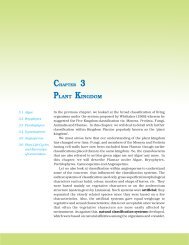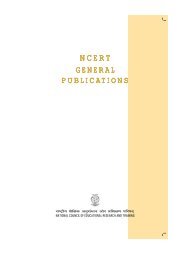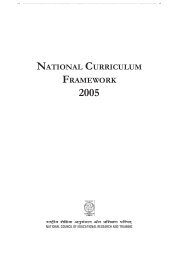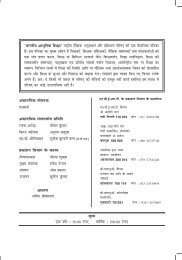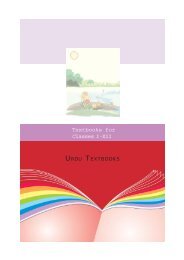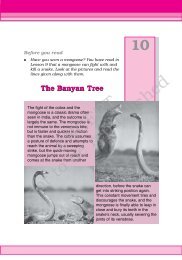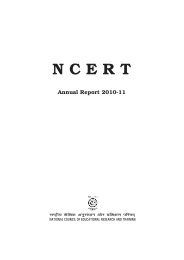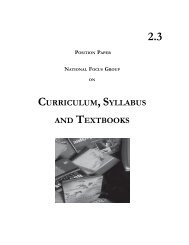indian education - National Council Of Educational Research And ...
indian education - National Council Of Educational Research And ...
indian education - National Council Of Educational Research And ...
You also want an ePaper? Increase the reach of your titles
YUMPU automatically turns print PDFs into web optimized ePapers that Google loves.
Religion, Education and Peace 45<br />
individual’s relationship with society and<br />
through that with nature. He held that<br />
human beings, despite being modern, are<br />
not really individuals in the truest sense<br />
of that word; they are still driven by social<br />
forces, by the worldview derived from<br />
their elders, peers, society at large and<br />
the times in which they live. These social<br />
forces are motivated by fear, ambition,<br />
and greed. Learning about the influences<br />
that direct one’s life and shedding the<br />
emotions of fear, greed, envy and anger<br />
through learning about them clears the<br />
way for compassion.<br />
So the moral truths that<br />
Krishnamurti sought came neither<br />
packaged as true belief, nor as knowledge<br />
and theories, but were intrinsic to a<br />
spontaneously-born sensitivity to life:<br />
‘Fear shuts out the understanding of<br />
life with all its extraordinary<br />
complications, with its struggles, its<br />
sorrows, its poverty, its riches and<br />
beauty—the beauty of the birds, and of<br />
the sunset on the water. When you are<br />
frightened, you are insensitive to all this’<br />
(Krishnamurti, 1963). Krishnamurti<br />
was convinced that our shortsighted<br />
instincts can be overcome and the right<br />
kind of <strong>education</strong> can show us the way<br />
to reclaiming the Earth for future<br />
generations.<br />
Edward Wilson recognises that our<br />
species’ destructive instincts are unique;<br />
they are not shared by other species with<br />
whom we live on Earth. With<br />
Krishnamurti, Wilson also recognises<br />
that science alone cannot solve the<br />
problem human beings have created. But<br />
whereas Wilson invokes the lost instinct<br />
we share with the whole of life as the path<br />
to salvation — ‘Every species, right down<br />
to nematode worms, has pretty elaborate<br />
behaviour that leads them to the right<br />
habitat at the right time. Shouldn’t we<br />
find some residue of that instinct in<br />
human beings? … On some level, it is wired<br />
into us to be around nature. We should<br />
not let that instinct disappear’.<br />
Krishnamurti puts his faith in the<br />
human ability to free the mind from the<br />
negative emotions of greed and violence,<br />
as a way of unlocking the shackles that<br />
bind individuals to self-interest.<br />
Krishnamurti’s vision for humanity<br />
resonates with thinkers both from India’s<br />
ancient and more recent past.<br />
His almost nihilistic radicalism is<br />
captured by the Buddhist Nagarjuna’s<br />
tribute to the Buddha in the last stanza<br />
of the Mulamadhyamakarika.<br />
I prostrate before the Gautama, who,<br />
grounded in compassion, taught the true<br />
dharma in order to destroy all opinions (or<br />
all points of view).<br />
His great passion for nature with<br />
Tagore’s idea of India’s civilisational<br />
values.<br />
Contemporary Western civilisation is<br />
built of brick and wood. It is rooted in the<br />
city. But Indian civilisation has been<br />
distinctive in locating its sources of<br />
regeneration, material an intellectual, in<br />
the forest, not the city, India’s best ideas<br />
have come where man was in communion<br />
with trees and rivers and lakes, away from<br />
the crowds. The peace of the forest has<br />
helped the intellectual evolution of man.<br />
The culture of the forest has fuelled the<br />
culture of Indian society. The culture that<br />
has arisen from the forest has been<br />
influenced by the diverse processes of<br />
renewal of life that are always at play in<br />
the forest, varying from species to species,<br />
from season to season, in sight and sound<br />
and smell. The unifying principle of life in



